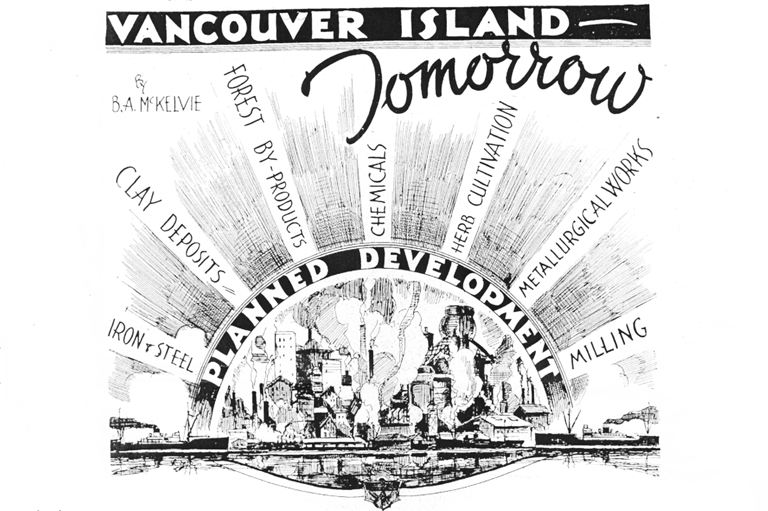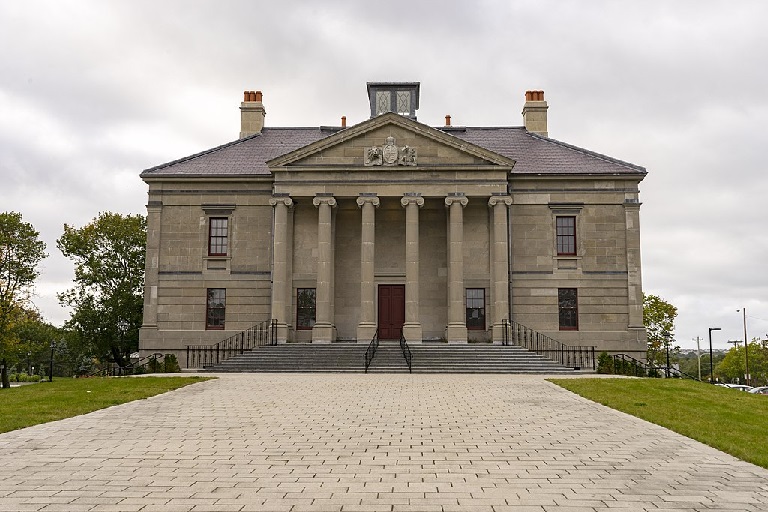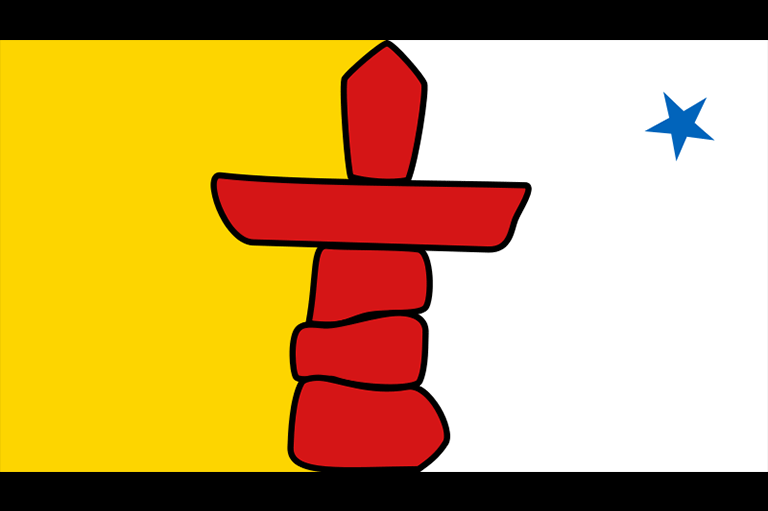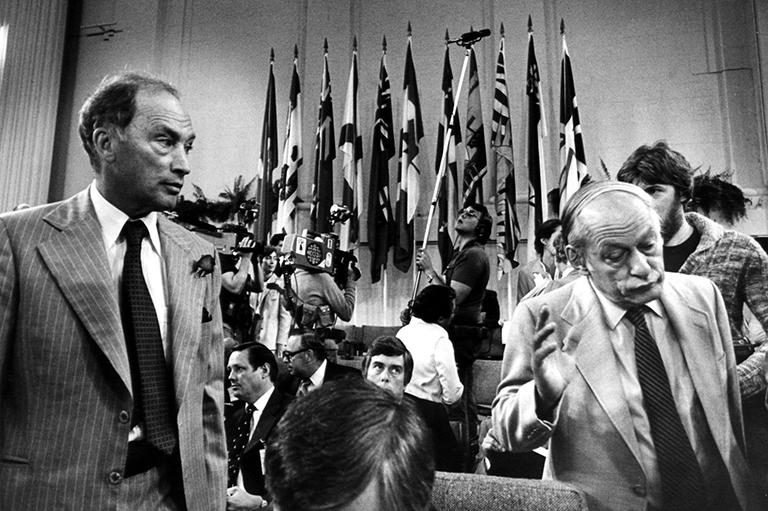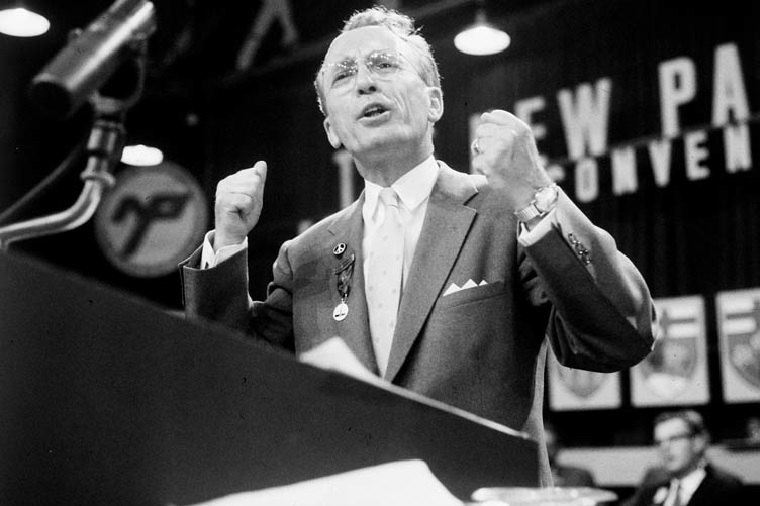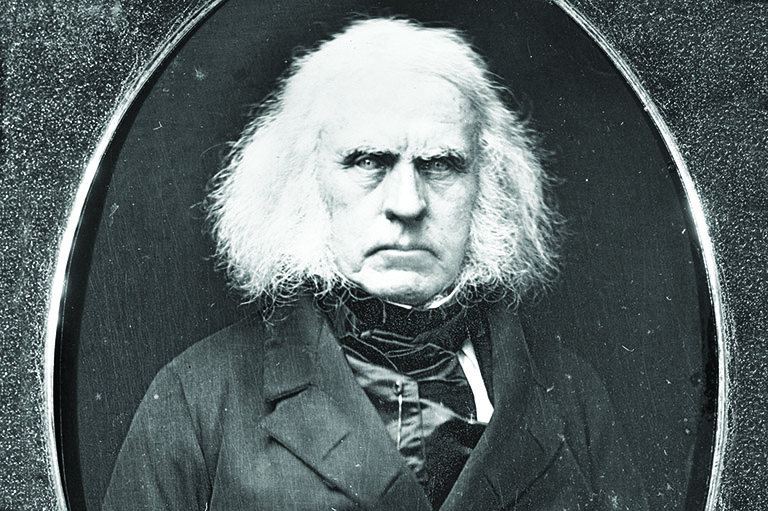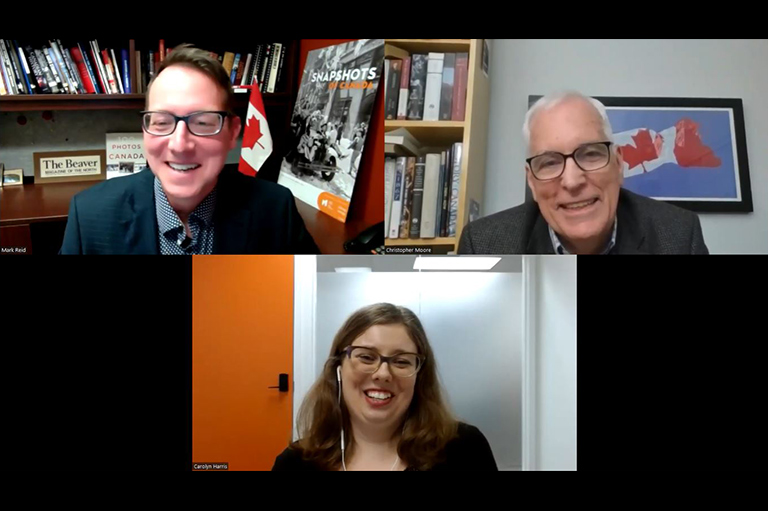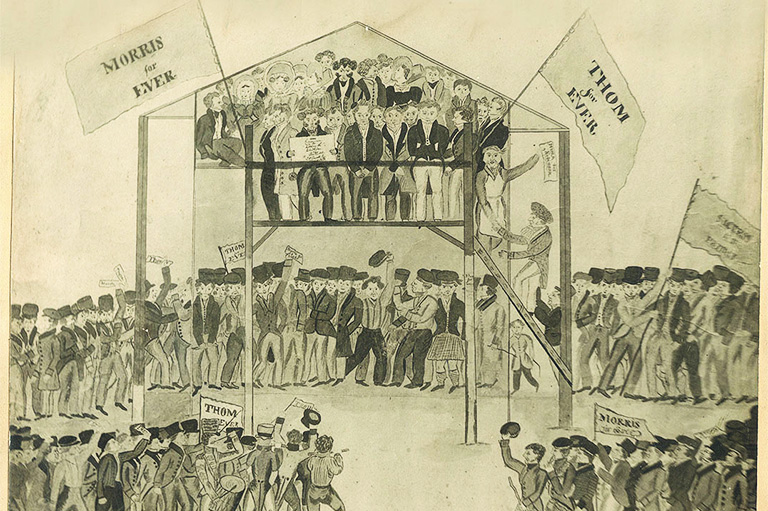Disparate Duo
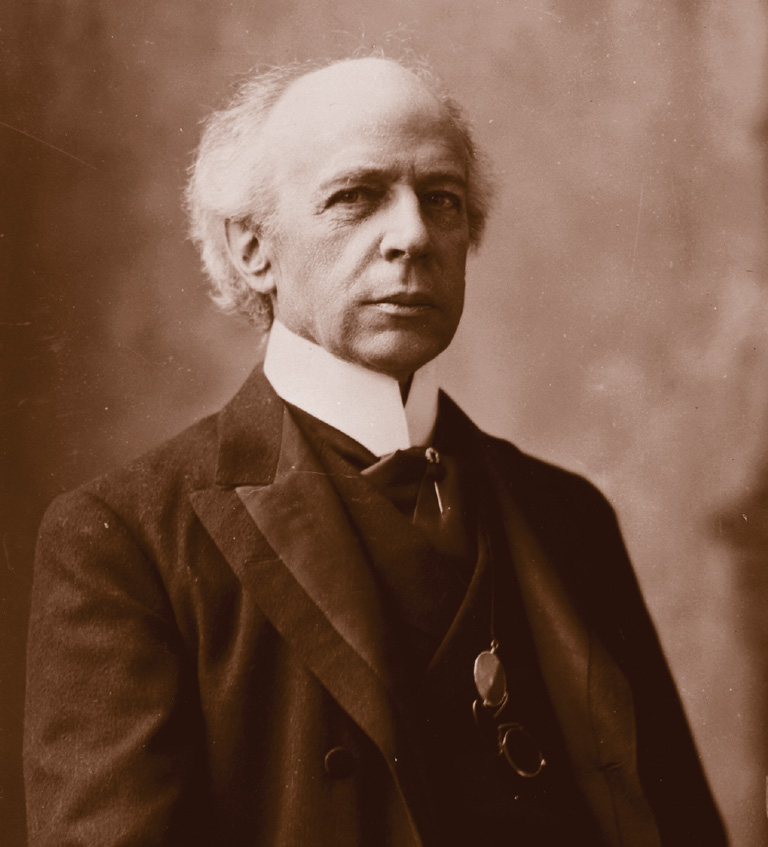
In 1901 Frederick Haultain, premier of the North-West Territories, proposed the formation of a single province comprising the area between Manitoba and British Columbia. The Canadian government countered with a bill to create two new provinces of approximately equal size and population.
Prime Minister Wilfrid Laurier argued that the territories were too large for one province and that Alberta would not accept rule from Regina, which had served as the territorial capital since 1882. Nor did Ontario and Quebec look favourably upon the emergence of a single, large western province to challenge their own domination of the federal parliament.
The two-province solution prevailed, and Alberta and Saskatchewan officially came into existence in September 1905.
One hundred years later, picnics, parades, and pageants mark the anniversaries. Such commemorations allow communities to define themselves and express their core values, to reflect on hardships overcome, progress achieved, and bright prospects that lie ahead.
They celebrate not the past itself, but rather a usable past, one that instills pride in the present and hope for the future.
At a deeper level, the Alberta and Saskatchewan anniversaries raise the question: how did two provinces that started out so much alike become so different from one another?
Alberta today is the heartland of free enterprise and low taxes, Saskatchewan, the symbol of medicare and Crown corporations.
James Blanchard, former U.S. ambassador to Canada, quotes a description of Calgary: “It’s just like Texas, only less anti-American.” No one would ever say that about Regina. Each province, in constructing its own identity, has helped determine what it means to be a Canadian. We all have a piece of Alberta and a little bit of Saskatchewan in us.
The “last, best West” in the late 1890s and early 1900s was the destination of hundreds of thousands of homesteaders seeking a better life. Both provinces boomed, Alberta’s population increasing from 73,000 in 1901 to 374,000 in 1911 and Saskatchewan’s from 91,000 to 492,000.
The arrival of large numbers of non-English-speaking immigrants spurred efforts to assimilate the newcomers to British Canadian culture and values. While both provinces were ethnically diverse, the mix was somewhat different.
Since Alberta was settled last, it benefited disproportionately from later waves of American settlers who moved north to take advantage of cheaper Canadian land prices.
In Alberta in the 1920s, settlers from the United States out-numbered Britons in rural areas by a ratio of two to one. In Saskatchewan, by contrast, Britons slightly outnumbered Americans.
Also, the majority of ex-Americans in Alberta were of Anglo-Saxon origin, whereas in Saskatchewan they tended to be non-Anglo-Saxons, such as Germans and Scandinavians.
Given the ethnic prejudices of the time, this meant that the Americans in Alberta were more likely than their Saskatchewan counterparts to assume leadership positions and influence the direction of society.
With 7 uniquely curated newsletters to choose from, we have something for everyone.
In the 1905 provincial elections, Liberals won 23 of 25 seats in Alberta and 16 of 25 in Saskatchewan. The two administrations adopted similar policies on key issues.
The Alberta government accused the Bell Telephone Company of failing to provide adequate service to rural customers. It bought out Bell in 1907 and established Alberta Government Telephones.
The Saskatchewan government did the same thing in 1909, except in Saskatchewan, the government owned only the long-distance lines and left local service to small companies organized at the municipal level.
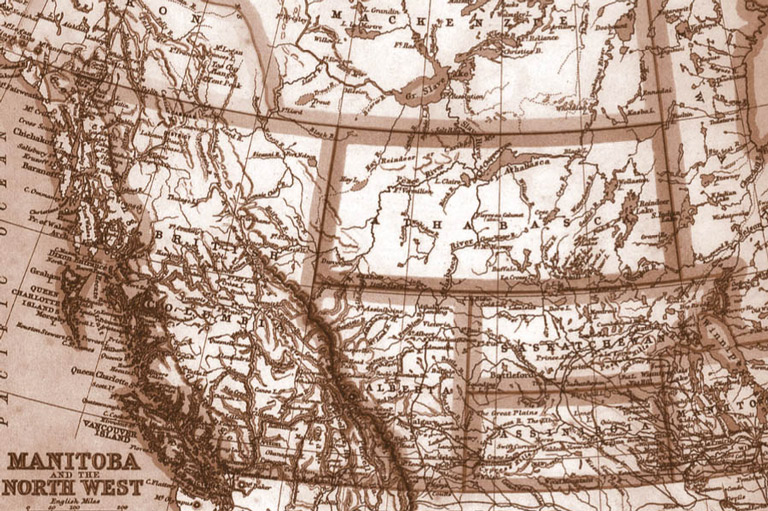
Premier Walter Scott preferred government assistance to outright ownership because he thought enterprises worked better if citizens had a stake in running them. Another example was the Saskatchewan Cooperative Elevator Company created in 1911.
Despite pressure from farm groups for direct government involvement in the grain handling business, the Scott government opted to loan money to a farmer-owned elevator company. Alberta premier Arthur Sifton adopted the same policy in 1913.
Both provinces passed legislation in 1909 to provide bond guarantees to railway companies for the construction of branch lines, alleviating the concerns of farmers who had trouble getting their crops to market.
The social policies of Alberta and Saskatchewan also ran along parallel tracks. Both provinces responded with patriotic enthusiasm to the outbreak of the First World War and shared in the resultant economic expansion.
The price of wheat tripled and acreage seeded doubled. The wartime spirit of sacrifice intensified social reform movements that had predated the war and now came to fruition.
Alberta voted in a referendum in July 1915 to prohibit the sale of alcohol, and Saskatchewan followed suit in December 1916. Saskatchewan women won the right to vote in March 1916, Alberta women one month later.
Save as much as 40% off the cover price! 4 issues per year as low as $29.95. Available in print and digital. Tariff-exempt!
The war also brought the agrarian protest movement to a new pitch. Western farmers had long considered themselves the victims of powerful corporations — grain companies, banks, and railways — all based in central Canada.
They believed that Ontario and Quebec called the tune, which translated into high tariffs designed to protect central Canadian manufacturers at the expense of Western commodity producers. During the war farmers felt doubly betrayed. The federal government first promised to exempt their sons from compulsory military service, then cancelled the exemption.
It imposed a ceiling on wheat prices when they were high, but removed the floor when they were low. The farmers’ pent-up frustration led to the formation of the Progressive Party, which sent sixty-four members of Parliament to Ottawa in the 1921 general election.
As agrarian protest came to a peak, Alberta and Saskatchewan began to part company. Alberta farmers followed the lead of Missouri-born Henry Wise Wood, who promoted the radical concept of “group government.” Wood rejected not only the Liberal and Conservative parties, but also the party system itself.
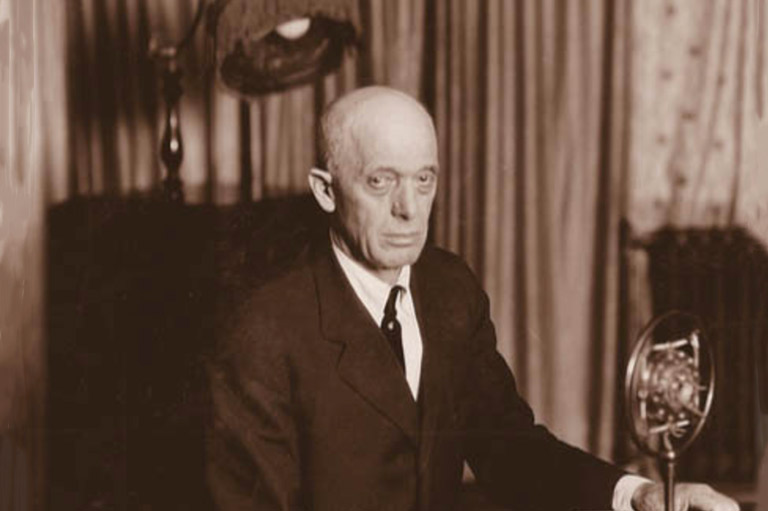
Believing that parties were bought and paid for by big corporations, he urged farmers to enter politics as an economic class. He encouraged other occupational groups, such as organized labour and professionals, to do the same. Then all the groups would come together to pass laws for the benefit of the whole community.
Attacked for advocating “Soviet” doctrines of class government that were alien to British traditions, Wood replied that he was only advising farmers to do what big business had already done, namely, organize to protect their class interests.
Henry Wise Wood was not just another farm leader demanding higher wheat prices and lower freight rates. He was a visionary and a prophet. He described the United Farmers of Alberta, which he served as president from 1916 to 1931, as “the child of my heart and the hope of my life.”
It embodied for him the ethical principle that “cooperation should infuse all human relations.” His philosophy was popular in Alberta partly because Americans formed a large proportion of the population. They had no particular attachment to British parliamentary traditions and were willing to consider alternatives based on grassroots democracy.
In addition, with Alberta being the last province to be settled, its farmers carried the largest debt loads and paid the highest transportation costs. They were ready for radical change.
Largely because of Henry Wise Wood, the UFA stayed clear of the old-line parties. Although group government as Wood envisaged it remained an unfulfilled ideal, the UFA was able to form a government in Alberta in 1921 and hold office until 1935.
When federal Progressives were lured back into the Liberal party (Prime Minister Mackenzie King called them “Liberals in a hurry”), Alberta MPs adhered firmly to their UFA beliefs. Wood kept up his campaign for democratic reforms, calling for free votes in Parliament, election of senators, fixed election dates, and the use of referendum and recall — ideas that were later picked up by Preston Manning’s Reform Party and its successors.
It is surprising how at the bottom of a political problem, some theology can often be found. Such was the case in the 1930s.
Unlike the UFA , the Saskatchewan Grain Growers’ Association worked with the provincial Liberals and kept them in office until 1929, when a Conservative-led coalition was elected for a term. The late 1920s were golden years for Saskatchewan.
The government boasted in 1927 that the province was first among the provinces in per capita wealth, first in the production of wheat, oats, rye, and flax, and first in horse breeding, commercial clay deposits, and sodium sulphate reserves. Saskatchewan with 921,785 people in 1931 ranked third among the provinces in population, behind only Ontario and Quebec. Alberta trailed with 731,605.
The 1930s Depression hit Alberta hard and Saskatchewan even harder. Per capita money income in Alberta in 1933 was 37.6 percent of what it had been in 1928. In Saskatchewan it was 25.7 percent. Relief expenditures in Saskatchewan in 1937 exceeded $40 million, dwarfing the entire 1939 provincial budget of $23 million. The situation was so bad that the government had to impose a new 2 percent sales tax to cover the promissory notes that had been given to teachers in lieu of salaries.
It is surprising how at the bottom of a political problem, some theology can often be found. Such was the case in the 1930s. In both Alberta and Saskatchewan preachers-turned-politicians appeared on the scene to lead the people out of the wilderness, but with markedly different results.
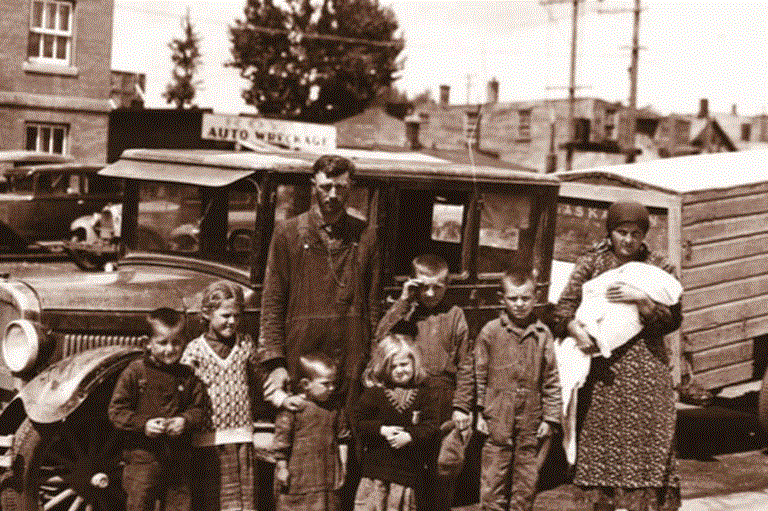
William (Bible Bill) Aberhart, a high-school principal, attended Presbyterian, Methodist, and Baptist churches before establishing his own Calgary Prophetic Bible Institute. (Unfriendly critics dubbed it the “Calgary Pathetic Bible Substitute.”) In 1925 he began broadcasting religious pro-grams over CFCN, a radio station with a powerful signal that covered all of Alberta as well as parts of the neighbouring provinces of British Columbia and Saskatchewan.
His audience on Sunday afternoons numbered 300,000, more than tuned in to hear Jack Benny’s comedy program. A farm boy from Rosetown, Saskatchewan, heard Aberhart on the radio and was inspired to enroll at the Bible Institute. He lived with the Aberharts, who treated him like a member of the family, the son they had never had. His name was Ernest Charles Manning, Aberhart’s successor as premier of Alberta and father of Preston Manning.
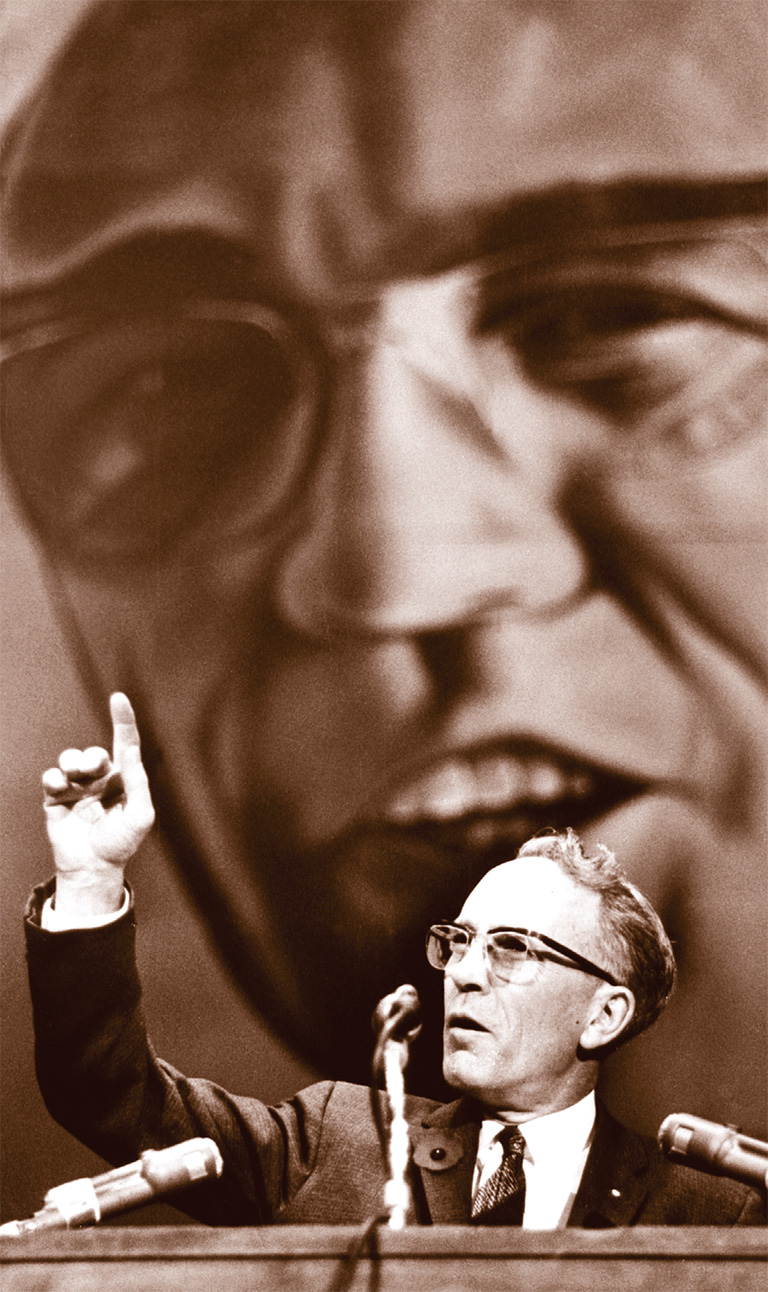
The 1920s was a time of intense theological debate between fundamentalists and modernists. The controversy came to a head at the 1925 Scopes trial when a Tennessee teacher was convicted for teaching the theory of evolution in a public school. Aberhart sided wholeheartedly with the fundamentalists.
For him it was “the Bible, the whole Bible and nothing but the Bible.” He thought that liberal interpretations of Christian doctrine led to a “creed-less church” that resembled a social action group more than a sacred institution. He was skeptical about the social gospel movement and its attempt “to build the Kingdom of God on earth.”
Social gospel reforms were as useless, he said, “as a farmer trying to purify a polluted well by painting the pump handle.”
The Depression focused Aberhart’s attention on politics. He noticed that some of his students were coming to school hungry because their parents could not afford to buy groceries. One of his most promising grade twelve graduates committed suicide after roaming hobo jungles in search of work.
Aberhart travelled to Edmonton in the summer of 1932 to help with the grading of provincial high school examinations. A fellow teacher handed him a copy of Maurice Colborne’s Unemployment or War, a simplified version of social credit, a monetary theory invented by Major Clifford H. Douglas. Aberhart took the book to his room in the University of Alberta student residence where he was staying and read it from cover to cover.
The next morning, as bright sunshine flooded the campus, he gazed out the window, secure in the knowledge that he had discovered the cure for the economic depression.
Meanwhile, Thomas Clement (Tommy) Douglas, the son of an iron molder, enrolled in 1924 at Brandon College to study theology. The college was embroiled in a battle between fundamentalists and modernists. Harris Lachlan MacNeill, professor of Latin and Greek, had been charged with heresy, and although he was ultimately acquitted, the experience of the trial shook up both the faculty and the students.
MacNeill was Douglas’s favourite teacher, the man, Douglas said, who taught him how to think. Upon graduating in 1930, the newly ordained minister accepted a call to Calvary Baptist Church in Weyburn, Saskatchewan, a city of 5,000 in the midst of the prairie dust bowl. He immediately became involved in assisting the unemployed and trying to improve the relief system. His sermons dealt with such topics as “Jesus and Capitalism” and “Jesus and War.”
He joined the Co-operative Commonwealth Federation (CCF) whose manifesto, adopted in Regina in 1933, promised to eradicate capitalism and put in place a “full program of socialized planning which will lead to the establishment in Canada of the Co-operative Commonwealth.”
As Douglas moved from the social gospel to socialism, Aberhart made the transition from fundamentalism to social credit. He began to mix economics into his Bible broadcasts, gradually introducing his listeners to proposals for monetary reform. They responded eagerly, and before long social-credit study clubs sprang up all over the province.
Aberhart created the Man from Mars series, a radio drama about a visitor from outer space who had come to earth to gather ideas about how to improve life on his home planet. The man from Mars soon came to the conclusion that earth was “the mental asylum of other planets.” How else could one explain the paradox of “poverty in the midst of plenty?”
Although Alberta had abundant natural resources, its citizens lacked the basic necessities of life. Goods for sale piled up on store shelves, but consumers did not have the wherewithal to buy them. Aberhart said there was not enough money in circulation because banks wanted to make profits at the expense of everybody else.
He attacked the “fifty big shots” and “high mucky-mucks” and pledged to restore purchasing power by distributing a monthly twenty-five-dollar “social credit dividend” to every adult in Alberta.
In the 1935 election, the Social Credit Party won fifty-six of sixty-three seats. Aberhart became premier, though he did not bother to make a speech in the legislature for four years. He preferred to communicate directly with the people through his radio broadcasts. In 1937 his government finally introduced legislation to implement social credit, but the laws were immediately disallowed because they infringed on the federal government’s power to regulate banks.
Aberhart heard the news while he was giving a speech at a picnic near Edmonton. When he told the audience what had happened, they reacted angrily. Someone shouted, “Give me a gun!” The premier calmed the crowd: “No! No! None of that! This is not bloodshed!”
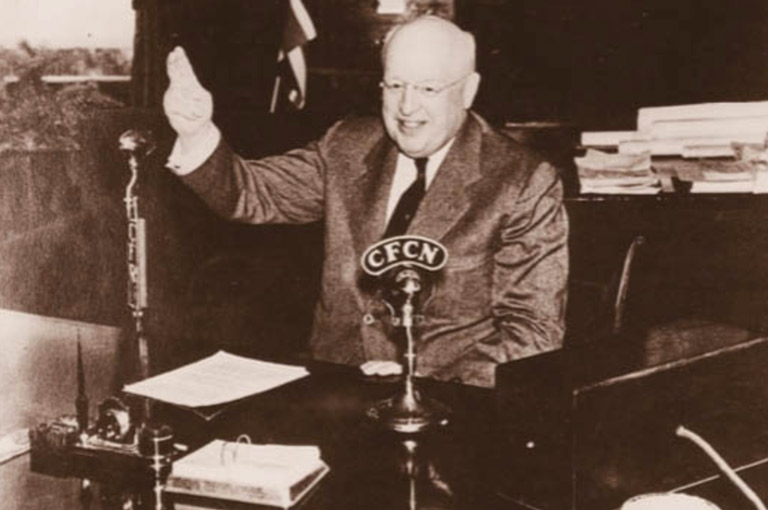
Even so, Aberhart blamed the federal government for his inability to introduce social credit, and he rejected a Government of Canada offer of financial aid because it was contingent on federal supervision of Alberta’s borrowing and budgeting practices. Aberhart allowed his province to default on interest payments to bondholders rather than accept dictation from Ottawa.
The CCF, on the other hand, supported a strong central government, which it considered necessary for the full implementation of the socialist program. Only the federal government had the capacity to plan the economy, nationalize industry and the banks, and build the welfare state. In the meantime, the provinces could take incremental steps to move the country in the desired direction.
The Saskatchewan CCF, under the leadership of Tommy Douglas, took power in 1944 and launched a whirlwind of change.
In its first term the government established three new departments (Social Welfare, Labour, and Cooperatives), passed a farm security act, and introduced the most prolabour trade union act in North America. Saskatchewan was the first province to allow civil servants to organize unions (1944), the first to enshrine a bill of rights prohibiting discrimination on the basis of race, colour, or creed (1947), the first to implement compulsory government automobile insurance (1946), and the first to insti-tute a hospital insurance plan (1947).
Douglas adopted a three-pronged approach to economic development, a mix of private enterprise, cooperatives, and Crown corporations. The latter included utilities (power and telephones), transportation companies (bus and airlines), and entrepreneurial ventures, such as sodium sulphate mining, a woollen mill, and a shoe factory.
By 1949 eleven Crown corporations provided 3,000 jobs and conducted business worth $25 million annually. The province basked in prosperity through the 1950s, the population rising by 90,000 between 1951 and 1960. The growth occurred even though the number of people on the land declined as agriculture became more mechanized and capital intensive.
Increased production of oil, gas, and uranium, and the beginnings of a potash industry helped diversify the economy so that the province began to escape its roller-coaster dependency on wheat.
Saskatchewan’s postwar growth, while impressive, did not match that of Alberta. The Leduc well south of Edmonton blew on February 13, 1947, inaugurating an oil boom that saw production rise from 7.7 million barrels in 1946 to 143.7 million barrels in 1956. Alberta vaulted past Saskatchewan in population, growing from 803,000 in 1946 to 1,332,000 in 1961.
Ernest Manning, who succeeded Aberhart as premier in 1943, quietly dropped social-credit nostrums and settled down to efficient administration based on a “philosophy of individualism, strong opposition to socialism, Cold War rhetoric, and anti-unionism.” The government left the development of natural resources to the private sec-tor, using the royalties to pay for roads, schools, hospitals, and social services.
The late 1940s was the turning point. Alberta abandoned the political experimentation of the 1930s Depression and pinned its future on oil wells. By 1965 Calgary was home to the headquarters of 965 companies involved in various phases of the petroleum industry, and Edmonton, too, emerged as a major refining and petrochemical centre.
U.S. investment and management dominated the industry, which reinforced the American influence that had been present since the early settlement period. The risk-taking bravado associated with oil exploration and drilling spilled over into the political culture. Alberta became the new frontier — brash, bold, and independent-minded.
In Saskatchewan the opposite happened. The Depression-born socialist party became entrenched in the institutions and mindset of the province. The CCF government held power from 1944 to 1964, when it finally succumbed to the Liberals under Ross Thatcher.
In 1961 Tommy Douglas introduced legislation to establish a universal, tax-supported medical insurance plan. In one bold stroke, he transformed health care from a private purchase to a public good. The doctors in the province went on strike on July 1, 1962, the day the plan was supposed to go into effect.
Since Douglas had resigned as premier in November 1961 to lead the federal New Democratic Party (as the CCF was now called), the burden of implementing medicare fell on Woodrow Lloyd. He almost broke under the strain.
“How much punishment can the people take?” he wrote. “How much can we justifiably expose them to?” Vandals spray painted “Commie” on Lloyd’s house, and health minister Bill Davies slept with a ten-gauge shotgun in the wastebasket next to his bed. The Regina police placed guards at the homes of cabinet ministers.
Finally, on July 23, 1962, the doctors signed an agreement to end the strike. Medicare proved so popular that in 1968 the federal government extended it across Canada.
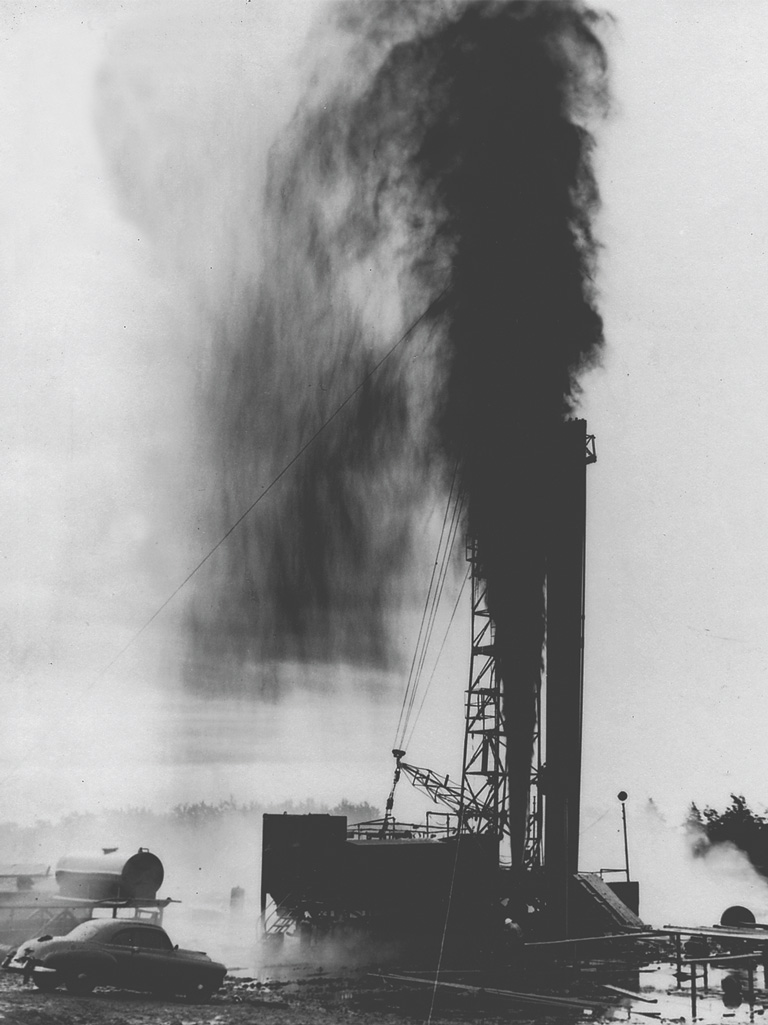
That year, too, Ernest Manning stepped down as premier of Alberta. Three years later the Social Credit Party passed into oblivion, swept out of office by the Progressive Conservatives under forty-three-year-old Peter Lougheed, who freely admitted that there were no profound ideological differences separating his party from Social Credit.
It was a matter, he said, “of selling the same free enterprise philosophy in a new package.” The Conservatives campaigned under the one-word slogan “NOW.” Everybody knew what it meant. Albertans wanted a government that reflected the youth, optimism, energy, and increasingly urban character of the province.
In 1973 OPEC jacked up oil prices, setting off another economic boom in Alberta. Provincial GDP almost doubled between 1971 and 1981, and the population grew from 1.6 million to 2.2 million. The federal government froze oil prices in Canada below the world price, and introduced new taxes to transfer oil wealth from Alberta to Ottawa. As a result, the province lost an estimated $50 billion in revenues in the 1970s and 1980s.
When the 1974 federal budget ruled that provincial royalties were no longer deductible in the collection of federal income taxes (which gave Ottawa more money), Lougheed characterized the move as “the biggest rip-off of any province in Canadian history.” He urged voters in the 1975 election to support his struggle. “It’s time for Albertans to stand together ... I need to know you are behind me.”
He was rewarded with 63 percent of the popular vote and sixty-nine of seventy-five members of the legislature.
In Saskatchewan, too, the resource battle heated up. World markets wanted what the province had to offer: wheat, oil, and potash. Allan Blakeney, the NDP premier who took office the same year as Lougheed, spent resource revenues to build on the social welfare legacy of the CCF.
He introduced a guaranteed income supplement for senior citizens, a family income plan for the working poor, a children’s dental service, and a prescription drug plan. Blakeney joined Lougheed in the fight for control of natural resources. The two men set aside political differences to forge a common front against Ottawa.
In one respect, Saskatchewan’s policy differed from that of Alberta. Lougheed preferred to leave resource development to the private sector, asserting the public interest through regulation and the collection of royalties.
Blakeney intervened directly through Crown corporations such as Saskoil, the Saskatchewan Mining and Development Corporation (mainly uranium), and the Potash Corporation of Saskatchewan. By 1979 the Crown Investments Corporation, the holding company for the crowns, had assets of $3.5 billion and revenues of over $1 billion.
The biggest gamble was the Potash Corporation (PCS). The throne speech in November 1975 announced the government’s intention “to acquire the assets of some or all of the producing mines in the province.”
Further, if agreement for sale could not be reached voluntarily, the government reserved the right to expropriate the assets it wanted. When the legislation came forward, the Opposition Liberals mounted a lengthy filibuster.
They said that government ownership of potash mines was unnecessary and would scare off investors. In the end, the Blakeney government did not use its powers of expropriation. It struck deals with private companies to acquire 40 percent of the industry.
Deputy Premier Roy Romanow said in 1977 “potash would be to the 1970s what medicare had been to the 1960s.” The prediction did not come true.
The Conservative Party led by Grant Devine defeated the Blakeney government in 1982 and privatized all the resource Crown corporations that the NDP had created. After prolonged and bitter debate (closure was invoked for the first time in the history of the province), PCS was sold.
The Blakeney government bought the mines when potash prices were high, and the Devine government sold them when prices were low — the worst possible scenario from a business point of view.
Saskatchewan has always had a competitive party system. From the 1930s onward the NDP (earlier the CCF) faced off against the anti-NDP party of the day, successively the Liberals, Conservatives, and the Saskatchewan Party.
This makes for exciting politics, but also inconsistency in public policy from one administration to the next. Alberta, by contrast, has a tradition of serial one-party dominance, first the Liberals, then the United Farmers of Alberta, Social Credit, and the Conservatives. The party in power typically has little opposition, but when it is defeated, it is gone forever.
The ruling parties of Alberta have all shared the same free enterprise, antisocialist philosophy. Social Credit may seem like an aberration, but only superficially so. Aberhart assailed the “fifty big shots,” but not the capitalist sys-tem itself. In any case, when the oil began to flow, Social Credit became a regular free-enterprise party.
Alberta’s political uniformity is partly based on a strong sense of regional grievance. Every premier from William Aberhart to Ralph Klein has rallied the voters in defence of provincial rights. Saskatchewan shares this pro-Western, anti-Ottawa feeling, but to a lesser extent.
More often a “have-not” province than a “have” province, it needs federal money more than Alberta does. It can-not bite the hand that feeds it. Alberta, on the other hand, pays vastly more in taxes to Ottawa than it receives in federal benefits. The American influence is also stronger in Alberta because of early settlement patterns and the structure of the oil industry.
Nor can the impact of personal leadership be discounted. If William Aberhart had lived in Weyburn and Tommy Douglas in Calgary, the histories of the two provinces might well have been different. Although Social Credit candidates did not do well in Saskatchewan, they fared best in areas of the province that were within reach of Aberhart’s radio broadcasts.
Until the 1930s the two provinces moved along not dissimilar historical trajectories. Their starkly divergent responses to the Depression set them travelling in opposite directions, a pattern that the oil boom in Alberta later consolidated. Saskatchewan has oil, too, but it has not been developed in sufficient quantity to drive the economy the way it does in Alberta.
The two centenarian provinces started out similarly, but evolved in contrary directions.
At birth, they might have been mistaken for twins, but clearly they were not. And yet, each in its own way has enjoyed success and contributed to the building of Canada. We admire the brassy entrepreneurialism and shoot-from-the-hip populism of Alberta, and Saskatchewan’s legacy of medicare and social justice is equally impressive.
Neither province allowed itself to be defeated by the challenges of developing the West, the up-and-down cycles of a resource-based economy, or the harsh adversity of the Great Depression. They seized the day and made the most of what they had.
Alberta and Saskatchewan are two poles of our national soul, and on their 100th birthdays we can celebrate them both.
More
We hope you’ll help us continue to share fascinating stories about Canada’s past by making a donation to Canada’s History Society today.
We highlight our nation’s diverse past by telling stories that illuminate the people, places, and events that unite us as Canadians, and by making those stories accessible to everyone through our free online content.
We are a registered charity that depends on contributions from readers like you to share inspiring and informative stories with students and citizens of all ages — award-winning stories written by Canada’s top historians, authors, journalists, and history enthusiasts.
Any amount helps, or better yet, start a monthly donation today. Your support makes all the difference. Thank you!
Themes associated with this article
Advertisement
You might also like...

Canada’s History Archive, featuring The Beaver, is now available for your browsing and searching pleasure!

Beautiful woven all-silk necktie — burgundy with small silver beaver images throughout. Made exclusively for Canada's History.

